Mark Levinson No. 5909 review: Worth the premium price tag?
Premium wireless active noise-cancelling over-ear headphones that cost a pretty penny
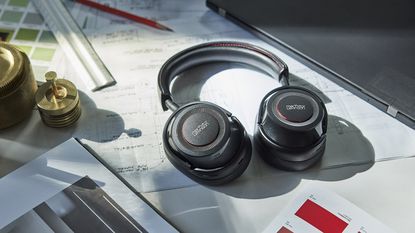
No, the No. 5909 can’t justify the asking price – but they get a lot closer to doing so than you might expect.
-
+
Positive, confident and eloquent sound
-
+
Premium materials, impressively assembled
-
+
Comfortable
-
-
Wantonly expensive
-
-
Truncated control app
-
-
Many realistically priced alternatives
Why you can trust T3

In this review, we’re looking at the most affordable way to get into Mark Levinson ownership. This is a brand that’s well-known to audiophiles, quite well-known to owners of more expensive Lexus vehicles (where its cost-option in-car audio systems are very well-regarded) and completely off the radar of those of us who might be considering a new pair of Sony or Bose wireless headphones.
‘Affordable’ is a relative term, of course, and even if the No. 5909 headphones are the least expensive product in the Mark Levinson catalogue, a quid shy of £1K doesn’t shout ‘bargain’ in too many people's language.

Mark Levinson No. 5909: Price and release date
The Mark Levinson No. 5909 are on sale now, and in the United Kingdom they cost a hefty £999. They’re an only-slightly-less eye-watering $999 in the United States, while in Australia the asking price is AU$1899.
At the risk of stating the obvious, that’s a lot of money. Some of the planet’s biggest and most accomplished brands will sell you some headphones that look and feel similar, do similar things and offer similar levels of satisfaction for a third of this price. A quarter, in some cases.
Mark Levinson No. 5909: What's new?
How, then, do these Mark Levinson over-ears attempt to justify themselves?
Given the restrictions dictated by the design of over-ear headphones, there’s nothing radical about the feature-set of the No. 5909. As the price demands, though, their features are, at least, the best of their type.
That means wireless connectivity via Bluetooth 5.1 with support for SBC, AAC, aptX Adaptive and LDAC codecs. It means a pair of 40mm beryllium-coated full-range dynamic drivers. It means adaptive active noise-cancellation (ANC) and a battery life of 30 hours or so if you leave ANC switched on, which rises to 35 hours if you switch it off. It means six hours of power after just 15 minutes of charging.
As a member of the Harman group of companies, Mark Levinson has access to the labours of the Harman acoustic engineers responsible for the ‘Harman curve’. In simple terms, the Harman curve is a graphic representation of the sound that most people find most agreeable most of the time. On paper, it reads like the sort of marketing non-science that ends up satisfying nobody, but in actual fact it’s an ideal. And Mark Levinson claims the No. 5909 adheres to the Harman curve more closely than any rival.
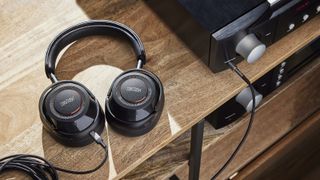
Mark Levinson No. 5909: Features and performance
By rights, this should be the point where the mask drops, and all the grudgingly delivered positives about the way the No. 5909 look and feel and are specified are undermined by righteous indignation. By rights, this should be the point where we pour scorn on the Mark Levinson headphones for not sounding any better than headphones costing a quarter of the price.
In actual fact, though, that’s going to have to wait for another day and another product. Because although the Mark Levinson No. 5909 don’t perform like every penny’s-worth of their asking price, they are a profoundly impressive pair of headphones.
Yes, they’re up against some very tough (and considerably more affordable) opposition from the likes of Bose, Bowers & Wilkins, Sennheiser and Sony. Heck, there are even Bang & Olufsen alternatives that are made to look a bit of a bargain when lined up against the No. 5909. But in every meaningful respect bar one, the Mark Levinson have nothing to learn from any of them - and in some ways they lead the pack.
- Best noise cancelling headphones 2024, from Bose, Sony, Apple, Beats and more
- Best wireless headphones 2024, including over-ear and in-ear Bluetooth buys
Take soundstaging, for example. The No. 5909 create a big, three-dimensional and utterly believable soundstage, and they organise specific strands of a recording on it with complete authority. Expansive or complicated recordings present no problems – these headphones make every element distinct and easy to follow. And they do this without undermining the sense of unity and togetherness that’s essential to creating a sense of performance. Music, no matter how many musicians were involved in its creation, sounds like the product of a single entity.
Where transient response and detail retrieval are concerned, too, the Mark Levinson could offer lessons. They identify the most minor, most fleeting occurrences in a recording, and put them into proper context – and, again, this is not at the expense of the overall presentation. But if there’s information to be revealed in a performance, the No. 5909 will reveal it in the most balanced and naturalistic way.
Control is of the martial variety, from the deep and straight-edged attack of bass information to the crisp-yet-solid top end. And in between, the Mark Levinson do thrillingly eloquent work in the midrange – they communicate in torrents, allowing a vocalist complete freedom to express themselves. ‘Hair-raising’ can be a trite, fall-back description sometimes, but here it’s entirely justified.
Dynamic headroom is considerable, rhythmic certainty is absolute, and momentum can be taken as a given. If a recording is supposed to soothe, it will do so; if it’s meant to startle and unsettle, then it will. The No. 5909 paint a complete picture, and they use all the colours.
But having laid the praise on with a trowel where sound quality is concerned, we have to row back a bit when it comes to noise-cancellation. There’s no doubt the Mark Levinson can deal with a fair amount of external sound, and they leave no suggestion of counter-signal in its wake – but you can spend considerably less and buy better noise-cancellation, no two ways about it. Especially if you spend your money on headphones wearing a ‘Bose’ badge.
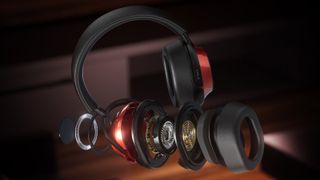
Mark Levinson No. 5909: Design and usability
Form is dictated by function where products like this are concerned, it’s true. But while there may be no point in reinventing the wheel, you can at least make it as upmarket and luxurious as possible. Which is what Mark Levinson has attempted to do with the No. 5909.
So these headphones are made from a combination of memory-foam covered in leather (which looks, feels and even smells expensive), anodised aluminium and quite the priciest-feeling plastics ever deployed on a pair of wireless over-ear headphones costing less than a thousand pounds.
Everything is fitted and finished with obvious care and precision, and the clamping force of the headband is nicely judged. By prevailing standards the No. 5909 are quite a compact design, and as a consequence they won’t swamp smaller-headed wearers like quite a few alternative designs do.
As well as the headphones themselves, the frankly colossal box in which they’re supplied includes a suitably expensive-feeling hard travel-case and a few pleasantly tactile cables. There’s USB-C to USB-C for charging, and two USB-C to 3.5mm cables for hard-wired operation – one is 1.25m long, the other 4m.
There are some physical controls arranged around the outer edge of each earcup too. On the right you’ll find the common three-button strip – here it deals with ‘volume up/down’, ‘answer/end/reject call’, ‘skip forwards/backwards’ and ‘activate voice assistant’. Over on the left, meanwhile, there’s a control covering ‘power on/off/Bluetooth pairing’ and another handling your choice of ‘ANC’ and ‘awareness’.
You’ll make your ANC choices in the clean, good-looking and rather truncated Mark Levinson Headphones control app (for iOS and Android). Select ‘on’, ‘off’ or ‘awareness’, and if you select ‘on’ you get to decide between ‘high’, ‘low’ and ‘adaptive’.
The app also features three EQ presets (or ‘bass contours’ as Mark Levinson insists upon): ‘neutral’, ‘attenuated’ or ‘enhanced’. There’s an adjustable auto-off timer to power down the headphones if no incoming signal is detected (30min, 60min, 180min or ‘never’), an indication of battery level, an ‘on/off’ switch for on-head detection, and, well, that’s your lot. It’s a decent app as far as it goes - it just doesn’t go all that far. Certainly the development team at Sony will be sleeping easily…

Mark Levinson No. 5909 review: Verdict
The Mark Levinson No. 5909 are not the pragmatic choice. Pragmatists will buy a pair of similarly specified headphones from one of the very prestigious brands mentioned below, and save themselves a lot of cash in the process.
But for those who have the wherewithal, who value exclusivity and (let’s not be coy) one-upmanship, you can rest assured all that money isn’t just going on a high-end logo.
The Mark Levinson No. 5909 headphones are, for those who can afford them, the real deal.
Mark Levinson No. 5909: Also consider
Apart from where price is concerned, there are quite a few alternatives to the Mark Levinson worthy of consideration. Sony’s all-conquering WH-1000XM4 are the first that spring to mind, given that they do everything they do really, really well – but you can also consider the Bose Noise-Cancelling Headphones 700 (for class-leading ANC) or the Bowers & Wilkins PX7 (for superb sound quality) at a fraction of the price of the No. 5909. To a lesser or greater extent they all do what the Mark Levinson do -– they just don’t have that aura of exclusivity about them as they do it.
T3 tests a wide range of products, from kayaks to kick scooters, mattresses to laptops, but the one thing that links them all is our approach to testing. Here's T3's How We Test page, so you know you're getting the real deal – actual time spent with testing products in the real world, not make-believe reviews based on spec sheets and assumption.
Sign up to the T3 newsletter for smarter living straight to your inbox
Get all the latest news, reviews, deals and buying guides on gorgeous tech, home and active products from the T3 experts
Simon Lucas is a freelance technology journalist and consultant, with particular emphasis on the audio/video aspects of home entertainment. Before embracing the carefree life of the freelancer, he was editor of What Hi-Fi? magazine and website – since then, he's written for titles such as Wired, Metro, the Guardian and Stuff, among many others. Should he find himself with a spare moment, Simon likes nothing more than publishing and then quickly deleting tweets about the state of the nation (in general), the state of Aston Villa (in particular) and the state of his partner's cat.
-
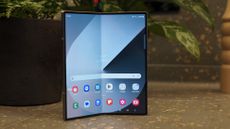 Samsung could adopt Apple-style tech for its next foldable
Samsung could adopt Apple-style tech for its next foldableCan a thinner design be achieved while supporting the S Pen?
By Britta O'Boyle Published
-
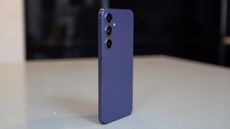 Samsung Galaxy S25 hands-on photos appear in massive pre-launch leak
Samsung Galaxy S25 hands-on photos appear in massive pre-launch leakGalaxy S25+ shows off its curves and leaves little to the imagination
By Chris Hall Published
-
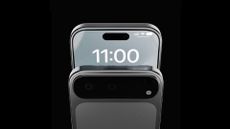 If the iPhone 17 Pro looks like this, I'll eat my hat!
If the iPhone 17 Pro looks like this, I'll eat my hat!Surely this is highly unlikely?
By Britta O'Boyle Published